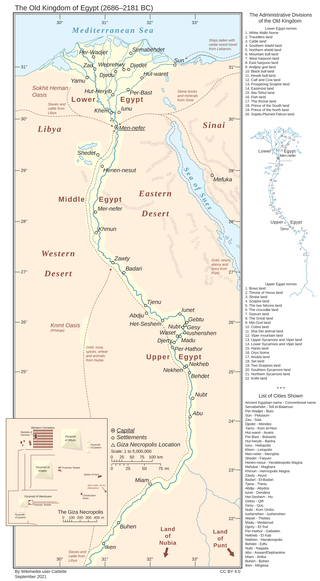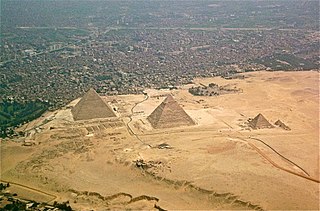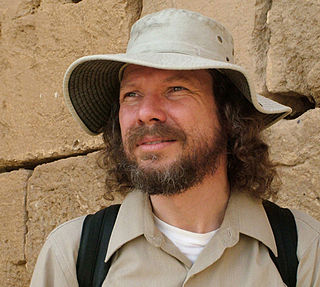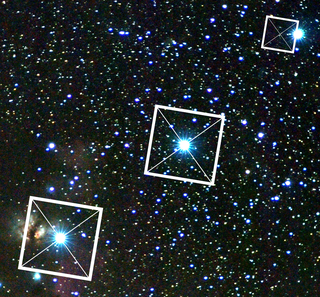
The Great Pyramid of Giza is the largest Egyptian pyramid and served as the tomb of pharaoh Khufu, who ruled during the Fourth Dynasty of the Old Kingdom. Built c. 2600 BC, over a period of about 27 years, the pyramid is the oldest of the Seven Wonders of the Ancient World, and the only wonder that has remained largely intact. It is the most famous monument of the Giza pyramid complex, which is part of the UNESCO World Heritage Site "Memphis and its Necropolis". It is situated at the northeastern end of the line of the three main pyramids at Giza.

Giza is the third-largest city in Egypt by area after Cairo and Alexandria; and fourth-largest city in Africa by population after Kinshasa, Lagos, and Cairo. It is the capital of Giza Governorate with a total population of 4,872,448 in the 2017 census. It is located on the west bank of the Nile opposite central Cairo, and is a part of the Greater Cairo metropolis. Giza lies less than 30 km (18.64 mi) north of Memphis, which was the capital city of the unified Egyptian state during the reign of pharaoh Narmer, roughly 3100 BC.

In ancient Egyptian history, the Old Kingdom is the period spanning c. 2700–2200 BC. It is also known as the "Age of the Pyramids" or the "Age of the Pyramid Builders", as it encompasses the reigns of the great pyramid-builders of the Fourth Dynasty, such as King Sneferu, who perfected the art of pyramid-building, and the kings Khufu, Khafre and Menkaure, who constructed the pyramids at Giza. Egypt attained its first sustained peak of civilization during the Old Kingdom, the first of three so-called "Kingdom" periods, which mark the high points of civilization in the lower Nile Valley.

Erich Anton Paul von Däniken is a Swiss author of several books which make claims about extraterrestrial influences on early human culture, including the best-selling Chariots of the Gods?, published in 1968. Von Däniken is one of the main figures responsible for popularizing the "paleo-contact" and ancient astronauts hypotheses.

The Great Sphinx of Giza is a limestone statue of a reclining sphinx, a mythical creature with the head of a human and the body of a lion. Facing directly from west to east, it stands on the Giza Plateau on the west bank of the Nile in Giza, Egypt. The face of the Sphinx appears to represent the pharaoh Khafre. The original shape of the Sphinx was cut from the bedrock, and has since been restored with layers of limestone blocks. It measures 73 m (240 ft) long from paw to tail, 20 m (66 ft) high from the base to the top of the head and 19 m (62 ft) wide at its rear haunches.
Pseudoarchaeology—also known as alternative archaeology, fringe archaeology, fantastic archaeology, cult archaeology, and spooky archaeology—is the interpretation of the past by people who are not professional archaeologists and who reject or ignore the accepted data gathering and analytical methods of the discipline. These pseudoscientific interpretations involve the use of artifacts, sites or materials to construct scientifically insubstantial theories to strengthen the pseudoarchaeologists' claims. Methods include exaggeration of evidence, dramatic or romanticized conclusions, use of fallacious arguments, and fabrication of evidence.

Graham Bruce Hancock is a British writer who promotes pseudoscientific theories involving ancient civilizations and hypothetical lost lands. Hancock speculates that an advanced ice age civilization was destroyed in a cataclysm, but that its survivors passed on their knowledge to hunter-gatherers, giving rise to the earliest known civilizations of ancient Egypt, Mesopotamia, and Mesoamerica.

The pyramid of Khafre or of Chephren is the middle of the three Ancient Egyptian Pyramids of Giza, the second tallest and second largest of the group. It is the tomb of the Fourth-Dynasty pharaoh Khafre (Chefren), who ruled c. 2558−2532 BC.

The pyramid of Menkaure is the smallest of the three main pyramids of the Giza pyramid complex, located on the Giza Plateau in the southwestern outskirts of Cairo, Egypt. It is thought to have been built to serve as the tomb of the Fourth Dynasty Egyptian Pharaoh Menkaure.

The Giza pyramid complex in Egypt is home to the Great Pyramid, the Pyramid of Khafre, and the Pyramid of Menkaure, along with their associated pyramid complexes and the Great Sphinx. All were built during the Fourth Dynasty of the Old Kingdom of ancient Egypt, between c. 2600 – c. 2500 BC. The site also includes several temples, cemeteries, and the remains of a workers' village.

Mark Lehner is an American archaeologist with more than 30 years of experience excavating in Egypt. He is the director of Ancient Egypt Research Associates (AERA) and has appeared in numerous tv documentaries.

The Giza Plateau is a limestone plateau in Giza, Egypt, the site of the Fourth Dynasty Giza pyramid complex, which includes the pyramids of Khufu, Khafre and Menkaure, the Great Sphinx, several cemeteries, a workers' village and an industrial complex. It forms the northernmost part of the 16,000 ha Pyramid Fields in the Western Desert edge of the Nile Valley that are part of the UNESCO World Heritage Site, Memphis and its Necropolis.

Pyramidology refers to various religious or pseudoscientific speculations regarding pyramids, most often the Giza pyramid complex and the Great Pyramid of Giza in Egypt. Some "pyramidologists" also concern themselves with the monumental structures of pre-Columbian America, and the temples of Southeast Asia.

Robert Bauval is an Egyptian writer and lecturer, perhaps best known for the fringe Orion Correlation Theory regarding the Giza pyramid complex.

Robert Milton Schoch is an American associate professor of Natural Sciences at the College of General Studies, Boston University. Following initial work as a vertebrate paleontologist, Schoch co-authored and expanded the fringe Sphinx water erosion hypothesis since 1990, and is the author of several pseudohistorical and pseudoscientific books.

Egyptian pyramid construction techniques are the controversial subject of many hypotheses. These techniques seem to have developed over time; later pyramids were not constructed in the same way as earlier ones. Most of the construction hypotheses are based on the belief that huge stones were carved from quarries with copper chisels, and these blocks were then dragged and lifted into position. Disagreements chiefly concern the methods used to move and place the stones.

The Orion correlation theory is a fringe theory in Egyptology attempting to explain the arrangement of the Giza pyramid complex.

The following outline is provided as an overview of a topical guide to ancient Egypt:

The Sphinx water erosion hypothesis is a fringe claim, contending that the Great Sphinx of Giza and its enclosing walls eroded primarily due to ancient floods or rainfalls, attributing their creation to Plato's lost civilization of Atlantis over 11,500 years ago.

Sūrīd ibn Salhouk is a legendary king from medieval Coptic and Islamic lore who is said to have lived 300 years before the biblical flood. In legends, Surid was often conflated with or identified as the biblical prophet Enoch, the Muslim prophet Idris, and Hermes Trismegistus.


















